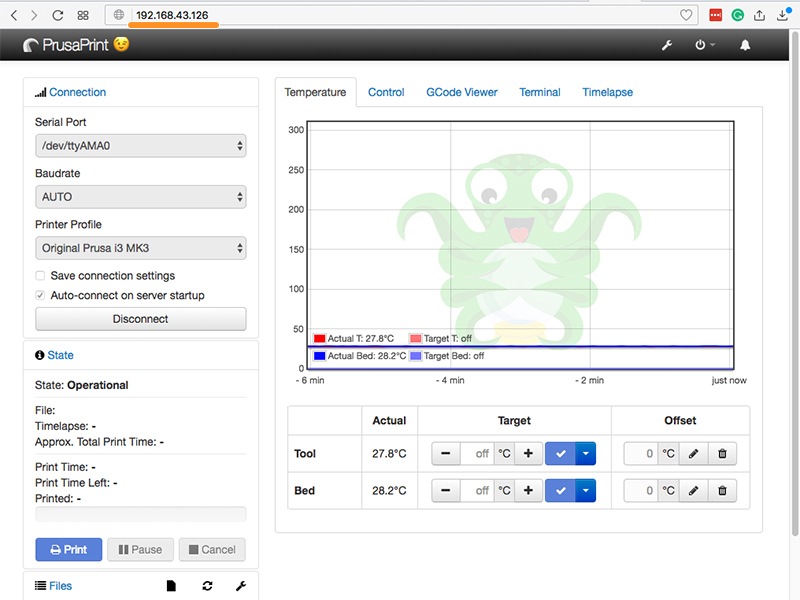

OctoPrint, on the other hand, offers a practical solution. However, these sparse connection options can quickly become annoying and uncomfortable. This means you must either load sliced models onto an SD card or transfer them via cable. Many low-cost 3D printers do not offer the option of wireless control or monitoring. This problem can easily be solved by the open-source software OctoPrint. In this case, the reason for failed prints is the lack of monitoring. Simplification of the Printing ProcessĮspecially if you need to run a print overnight every now and then, you will know the problem of failed prints. Since then, it has been continuously improved by experienced engineers and new versions and features are regularly released as plug-ins.

It allows you to remotely control your 3D printer and was developed by Gina Häußge in 2012.

OctoPrint is a 3D printing application based on Raspberry Pi*. 4.4 What are the alternatives to OctoPrint?.4.3 What is the so-called spaghetti detective?.4.2 What are the basic features of OctoPrint?.4.1 Why is OctoPrint so popular with 3D printer users?.2.6 Step 6: Focusing the Raspberry Pi camera.2.5 Step 5: Switch on the Raspberry Pis on the Ender 3.2.3 Step 3: Mounting the Raspberry Pi camera.2.2 Step 2: Printing the Ender 3 OctoPrint parts.2.1 Step 1: Making the correct OctoPrint settings for your Ender 3.
 1.1 Simplification of the Printing Process. Update : I bought a PowerJive USB power meter and re-tested everything, and came up with ~80 mA instead of the ~30 mA reported by the Charger Doctor that I was using prior. This seems to be more in line with the results others were measuring with much more expensive/accurate meters in the Raspberry Pi forums: Raspberry Pi Zero power consumption. Seems the Pi Zero is only incrementally better than the A+-still excellent news, but not nearly as amazing as I originally thought :( I've updated the numbers in the post below to reflect this change. Update : With the new Pi Zero 2 W, you can also disable some of the CPU cores to reduce power consumption for a heavily-utilized Pi if it doesn't need all the CPU cores running. I decided to spend some time testing these theoretical power-saving techniques on my Pi Zero, and here are some of the tips I've come up with (note that these techniques work with any Pi, not just the Zero): Technique Yesterday my post comparing the Raspberry Pi Zero's power consumption to other Pis hit the Hacker News front page, and commenters there offered a few suggestions that could be used to reduce the power draw even further, including disabling HDMI, changing the overclock settings, and futzing with the lone ACT LED. If you're running a headless Raspberry Pi, there's no need to power the display circuitry, and you can save a little power by running /usr/bin/tvservice -o ( -p to re-enable). Add the line to /etc/rc.local to disable HDMI on boot.
1.1 Simplification of the Printing Process. Update : I bought a PowerJive USB power meter and re-tested everything, and came up with ~80 mA instead of the ~30 mA reported by the Charger Doctor that I was using prior. This seems to be more in line with the results others were measuring with much more expensive/accurate meters in the Raspberry Pi forums: Raspberry Pi Zero power consumption. Seems the Pi Zero is only incrementally better than the A+-still excellent news, but not nearly as amazing as I originally thought :( I've updated the numbers in the post below to reflect this change. Update : With the new Pi Zero 2 W, you can also disable some of the CPU cores to reduce power consumption for a heavily-utilized Pi if it doesn't need all the CPU cores running. I decided to spend some time testing these theoretical power-saving techniques on my Pi Zero, and here are some of the tips I've come up with (note that these techniques work with any Pi, not just the Zero): Technique Yesterday my post comparing the Raspberry Pi Zero's power consumption to other Pis hit the Hacker News front page, and commenters there offered a few suggestions that could be used to reduce the power draw even further, including disabling HDMI, changing the overclock settings, and futzing with the lone ACT LED. If you're running a headless Raspberry Pi, there's no need to power the display circuitry, and you can save a little power by running /usr/bin/tvservice -o ( -p to re-enable). Add the line to /etc/rc.local to disable HDMI on boot.








 0 kommentar(er)
0 kommentar(er)
